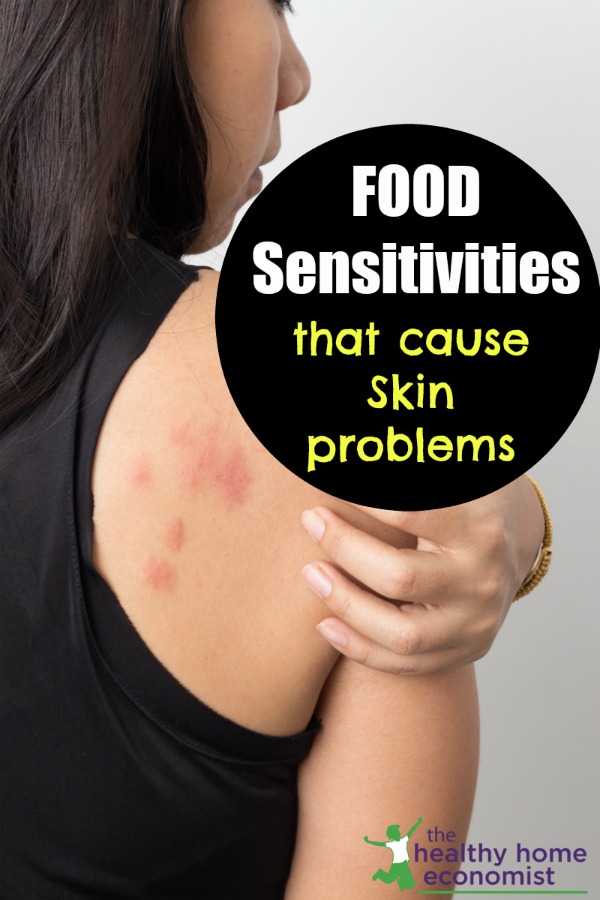Table of Contents[Hide][Show]

Food sensitivities are dramatically on the rise and the same can be said for skin disorders. Looking back even a decade ago, being sensitive to some kinds of food was not the hot topic that it is today. Going back 50 years ago, it was virtually unheard of!
For example, the “trend” we are seeing among people going wheat and gluten-free is proof of this. The truth is this is not a trend that is going to go away anytime soon. According to gluten specialist, Dr. Tom O’Bryan, 7 out of 10 people have a sensitivity to gluten whether they know it or not.
That surely sounds like an epidemic to me!
Just because someone is not diagnosed with Celiac disease doesn’t mean that there isn’t a problem. Like with any diagnosis, gluten intolerance doesn’t develop overnight, and in time, the sensitivity could progress drastically if intervention is not taken.
It’s also worth noting that for every person who has gluten sensitivity with gut dysfunction symptoms, there are 8 that don’t. Like with any food sensitivity, we cannot assume that it will only affect us in one way.
Most think of gluten as a “gut issue”, but this is not necessarily so. Food sensitivity symptoms, like gluten, can manifest in different ways for different people.
The big picture is that there are typically multiple food sensitivities in a single individual with this problem. It’s very rare that I see people with just one food sensitivity in my practice, which is much different than a true food allergy.
True Food Allergy vs Food Sensitivity?
A food allergy has an immediate response on the body. It can be potentially deadly and trigger instant symptoms such as a rash, itching, swelling, wheezing etc. The most common food allergies are shellfish and or fish, peanuts, nuts, soy, dairy, and eggs. Food sensitivities and intolerances are far more common than allergies.
Unlike a food allergy, a sensitivity could take up to 72 hours for symptoms to show.
The list of potential symptoms is almost endless, as a food sensitivity can manifest in many different forms. Some of the most common food sensitivity symptoms include:
- Skin conditions such as acne, eczema, psoriasis, rashes, rosacea
- Digestive Distress: constipation, diarrhea, cramping, bloating, gas
- Headaches/ Migraines
- Fatigue/ low energy
- Difficulty losing weight/ obesity
- ADD/ ADHD
- Arthritis
- Ear infections
- Sinus Infections
- Achy and painful joints
… To name but a few!
The tricky thing about food sensitivities is that they can be perfectly healthy whole foods; foods that we would not normally suspect to be a problem!
As I have discussed in prior articles about the importance of gut health to clear skin, a damaged gut is a breeding ground for food sensitivities.
There are particular foods that can aggravate an already irritated stomach, and/or prevent it from healing, as well as create even more inflammation throughout the body.
Foods that Affect the Skin
The following foods, in particular, are those that tend to affect the skin. Note that everyone is different, however. Some may only be sensitive to some, while others may be sensitive to all!
- Wheat/Gluten
- Grains (authentic sourdough may be tolerated)
- Dairy (raw dairy, ghee, and butter may be exceptions)
- Eggs (typically the white rather than the yolk)
- Nuts (soaked/sprouted nuts may be tolerated)
- Soya including all types of edamame
Many will see a huge change in their skin after removing these foods from their diet. If still no difference is noticed, consider specific food groups that are also known to exacerbate symptoms:
Nightshades
Nightshades are a group of foods known to increase inflammation in the body, and because most skin issues are inflammatory conditions, eliminating these can also be a step to relieve symptoms. These typically include potatoes, tomatoes, sweet and hot peppers, eggplant, tomatillos, tamarillos, pepinos, pimentos, paprika, and cayenne peppers.
Histamine containing foods
The process of fermentation produces histamine, and some are more sensitive to this than others, especially if they already have a build-up of it in their system. For some, the bacteria in their gut may be producing excess histamine.
This may also be why certain people cannot tolerate fermented foods. Although it may be impossible to completely avoid histamine, following a low histamine diet may be helpful for some. This is a partial list of common foods that are high in histamine: (1)
- Alcoholic beverages, especially beer and wine.
- Anchovies
- Avocados
- Cheeses, especially aged cheese, such as parmesan, blue, and Roquefort.
- Cider and other homemade fermented beverages such as homemade root beer.
- Dried fruits such as apricots, dates, prunes, figs, and raisins (you may be able to eat these fruits – without reaction – if the fruit is thoroughly washed).
- Eggplant
- Fermented foods, such as pickled or smoked meats, sauerkraut, etc.
- Mackerel
- Mushrooms
- Processed meats – sausage, hot dogs, salami, etc.
- Sardines
- Smoked fish – herring, sardines, etc.
- Sour cream, sour milk, buttermilk, kefir, yogurt – especially if not fresh.
- Soured breads, such as pumpernickel, coffee cakes and other foods made with large amounts of yeast.
- Spinach, tomatoes
- Vinegar or vinegar-containing foods, such as mayonnaise, salad dressing, ketchup, chili sauce, pickles, pickled beets, relishes, olives.
- Yogurt
FODMAP Foods
FODMAP stands for Fermentable Oligosaccharides, Disaccharides, Monosaccharides And Polyols. Like histamine that can be produced by gut bacteria, because these carbohydrates are not completely broken down and absorbed in the GI tract, they can cause fermentation and symptoms such as diarrhea, pain, and gas in some people.
You may already be familiar with the GAPS diet, or the Specific Carbohydrate diet to address gut dysfunction. Avoiding foods that contain these sugars may also be an additional approach, or one on it’s own to consider, especially if you already have a gut diagnosis such as colitis or IBS. (2)
It’s possible to be intolerant to several different foods. Start with the major sensitivities above and begin to eliminate one food group at a time. Give your body at least 1-3 months to see results. If no large improvements, move on to the next group. For a quick at-home test to check for food sensitivities, try the pulse testing allergy method.
Summary
Although these three categories are typically the largest culprits for people in terms of skin irritants in the diet, food sensitivities could also be any random food, especially if digestion is not working optimally.
These are general recommendations I have established from my research, working with clients, and personal experience. While not everyone will have to remove everything suggested here, some may be hypersensitive to many foods, and in that case further investigation may be needed, as well as working with a practitioner that can cater to your body’s needs.

References
(1) Histamines in Food
(2) Fermentable oligosaccharides, disaccharides, monosaccharides and polyols (FODMAPs) and nonallergic food intolerance: FODMAPs or food chemicals?








Hi Sarah, recently starting in May of this year, I started getting little red bumps under and at the far corners, my eyes having little itch, but if touch are painful around the lid and under eye. Went to the doctor, no change, I’ve been 7sing hydrocortisone since June along with Vaseline. I can’t figure out what’s causing it, I haven’t changed a thing in my life for this to happen, assuming it’s a dermatitis, but it won’t go away. Some days it looks to appear gone, a couple days later it’s back.
Any suggestions
Thank you
Paula
50 years old. Always able my whole life to eat anything without any problems. About a year ago, I noticed a prevalent increase in pimples. Not the kind of acne I had as a teen on my face. A cheesy, stubborn almost wart like condition on my hands, arms, scalp, neck, shoulders, back, etc. Frustrated with doctors I took the research on myself.
Celiac disease. Commonly associated with gluten.
Just one problem. I never had a problem with gluten before. The answer didn’t seem satisfactory. But Celiac was the diagnosis. Started researching Celiac and discovered gluten isn’t the only cause. The National Institute of Health provided a well written extensive report on the chemical, Glysophate, the main active ingredient in Roundup. Monsanto discovered that if Roundup is applied to crops just before harvest, the yield increases. But, in the process the crops could be harmed. So, Monsanto genetically modified crops to withstand Roundup. That allowed even more Roundup to be applied to crops. Of course that means just one thing. Even more Roundup is entering the food supply. It’s not just wheat anymore. Corn, soybeans, beets, sugar cane and more all have Roundup.
GMO’S are entering the food supply primarily to be Roundup resistant. Your food contains Roundup.
What can Roundup do besides Celiac disease?
Depression, head aches, naseau, diarrhea. Diabetes, End Stage Renal Disease which is total kidney failure, Gall Bladder failure, cancer, liver problems, gut (probiotics), birth defects, miscarriage and more.
After reading the National Institute of Health report a light bulb went off. Wife diagnosed with type 2, then LADA type 1 diabetes. I’ve had my gall bladder removed.
Roundup should be banned. It is a poison.
I now pay attention to the food we are eating, specifically if it is GMO. Unfortunately the label doesn’t always state it. Some food manufacturing companies might state their position on their website. For example Coca-Cola indicates on their website GMO’S are used in their products.
If you stuck with my long rant so far, then you haven’t seen anything yet. READ the National Institute of Health report on Glysophate
ncbi.nlm.nih.gov/pmc/articles/PMC3945755/
Terry, that sounds like an allergic reaction. That’s serious. Also, use commas when you write. Your paragraph gave me a headache.